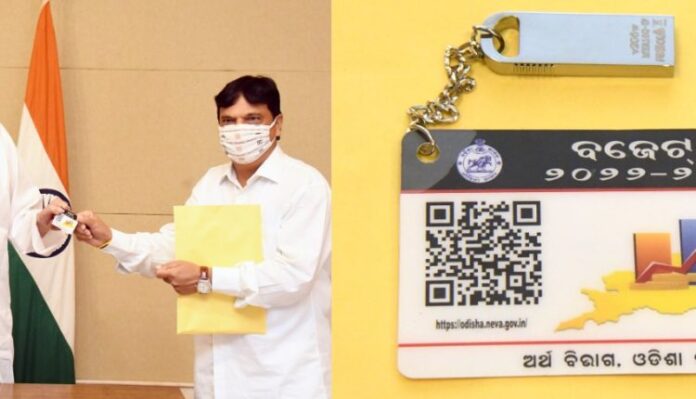FY 2022-2023 will see Odisha handling an outlay of Rs 2-lakh crore which hints at it being an outcome budget, at least in setting a norm, if not a whole hog rigor at this stage. As 5T & Mo Sarkar, the formal development drivers are settling in, it is time to look analytically at the performance of various ministries (departments) handling development programs. The expenses incurred by the departments and their matching outcomes need to be measured objectively. At the end of the budget period, 5T department with the help of the MoF can compile a progress card on what various departments have done with the amount assigned in the annual Budget. It will measure the outcomes of all government programs and evaluate whether the money has been spent for the purpose it was sanctioned. When 5T was introduced, I had specifically pointed out the possibilities of systemic transformations due to 5T and its future linkages with the budget outlay of Odisha. 5T will provide the basis of outlay and the metrics for performance measurement. If we could close the loop of accountability for each pie spent, the Odisha Model can be a part of a global practice. Political stability certainly lends fiscal discipline and gives enough time to observe, record and disseminate the change. Governments despite putting in a lot where it matters, can’t harvest the fruits. Many times, they are not there to even realize that the change has happened. In Odisha, 5T is the umbrella drawing board and the gauze. It should be realizing its mission and help in the absorption of this budget’s enhanced outlay in comparison to last year’s. The 17-18% increase should result in a minimum 2X impact.
Almost all the budget expenditure, about 99% will be met from revenue sources and about 1% from loans. The process of conversion of the expenditure to tangible and intangible outcomes is not a straight one. Because there are several intermediate stages and complementary resources required in achieving the intended impact. But the departments have to own up the outlays and sensitize down below with the fact that the financial resources are deployed for achieving certain outcomes. In the coming years this will no more be a theoretical pipe dream. The pressure of targets has entered the room and is here to stay. Targets for both outputs and outcomes. This year the revenue sources for the state will be expected to contribute Rs 36,978 crore (state’s share from the taxes imposed by the Centre), the state’s own tax revenue of Rs 46,000 crore and non-tax revenue of Rs 48,200 crore and the Central allocation of Rs 32,789 crore. It seems the total tax and non-tax revenue in the first two months, April and May have registered about 36% higher in comparison to last year same period. Non-tax revenue is from the mining sector. I am concerned about the coal mining. As India will strive towards achieving the 2070 net zero target, Odisha’s contribution to the nation’s energy transition will be more important than perhaps what we assume now. In 2020-21, Odisha produced the second-highest quantity of coal (over 154 million tonnes) in the country. It is believed that this will help in reducing imports and hence protect the capital of the country. But what about the environment and the coal mining communities? Does the non-tax revenue from mining, including coal, comes at humanitarian cost?
The welfare programs in health, employment, education, food and women development have been supported by the budget but in some cases inadequately. Some of the allocations are — Rs 2,664 crore for the ‘Biju Swasthya Kalyan Yojana’ (Health Insurance), Rs 500 Cr towards the MGNREGS and Rs 2,001 Cr for the MGNREGA scheme, Rs 1,023 Cr towards food security, Rs 2,000 crore for Mission Shakti Department, Rs 700 Cr for the employment program MUKTA. Creating opportunities for poor urban people and migrant labourers needs more investment. The uncertainty in agriculture and outbound labour has to be protected as much as possible. I was expecting more outlay in MUKTA, agriculture research & education (Rs 161 Cr) and flood control measures (Rs 968 Cr). These are closely related. Agriculture has not been efficient and is overtaken by manufacturing and service sectors but continues to be mothballed for bad times. R&D in agriculture needs immediate boost. Rs 3581 Cr allocated for Samagra Shiksha is a wise step. Since the last three years, this drive has focused on improving quality of education, enhancing learning outcomes and using technology to help children and teachers for development of school education (from Class I to Class 12) at the district level. The outcome of this initiative has the potential to immediately contribute to the SGDP by building the base of our coming generations. Last year the allocation was Rs 3,157 Cr and this year it is Rs 3,581 Cr. Rs 100 crore for high school transformation program looks inadequate because this is a capital-intensive program and quite a diversified one. This has been treated as a subdivision and not as a main division. This has surprised me. Development of MSME & Start-up promotion has been announced about 30% more than the previous year’s allocation but we should know the unspent and the work in progress to arrive at a more realistic figure of allocation.
Budget provisions for Jhajhanbati Project in Koraput, Mid-day meal schemes, KALIA scheme do not surprise me. Rs 312 Cr for horticulture and Rs 112 Cr for income support to farmers’ families, is spent well, should be enough. But the challenge is the outreach and the accountability in doing so.
The Budget Stabilisation Fund takes the cake. This is intended to insure the Budget from revenue uncertainty and volatility and help the state continue undisrupted with its programmed expenditure and programs. The Budget Stabilisation Fund is required to absorb possible future revenue shocks due to the unimaginable and ominous swing in mining revenues and international commodity prices. Odisha is most unlikely to escape the geopolitical turmoil.
This budget has provisioned more for capital expenditure, more than 50% addition to last year’s allocation. Under the Capital Outlay, there are allocations for Biju Expressway, State Capital Project, Augmentation of Basic Amenities and Development of Heritage and Architecture (ABADHA) at Puri, Ekamra Khetra Amenities and Monuments Revival Action Plan (EKAMRA), Samaleswari Temple Area Management & Local Economic Initiative (SAMALEI), Integrated Development of Heritage, Monuments & Tourist Destinations, Connecting Unconnected Villages in Difficult Areas (CUVDA) and others. Special focus is given to the development and preservation of cultural heritage. This will help boost the cultural economy of Odisha. The size and potential of the economy is forever growing rapidly, since the last decade. I had written this earlier in the context of the cultural economy of Odisha, “Art and culture is the permanent treasure. Its fast depletion is making us poorer every year. In 2022, culture-based explanations for economic development will have to make a comeback in Odisha. Cultural activism and concomitant creativity in general population can make us richer in 2022. GDP is grossly incomplete without arts and culture.” Rs 132 crore has been provided for the promotion of Odia Language, Culture, and Heritage, and this includes the important Rs 46 Cr for Mukhyamantri Kalakara Sahayata Yojana and Rs 15 Cr for preservation, conservation, and protection of monuments and sites which reflect the rich cultural heritage of our state. Mukhyamantri Kalakara Sahayata Yojana will help in bringing back tangible social security of the art community and this will be crucial as a confidence building measure among the artistes. But why Rs 56 Cr has been earmarked for Directorate of Culture is beyond my understanding. The Department of Culture and the University of Culture possess the mandate to change Odisha and Odias, but we haven’t seen anything transformational happening there. So, allocating more budget isn’t a surefire way of rejuvenating them and making them deliver. Along with funds, please give them a funds Burn Plan.
Capital expenditure is the money spent by the government on the development of machinery, equipment, building, health facilities, education, etc. It also includes the expenditure incurred on acquiring fixed assets like land and investment by the government that gives profits or dividend in future. We need the state to multiply capital assets, broad based and diversified.
I was quite expecting the allocation for social sector to go up substantially and now 34% of the total expenditure is no small jump. The hikes have been in the areas of education and skill development, public healthcare, housing and urban development department, pipe and drinking water under Jal Jeevan Mission and Basudha and construction and improvement of roads. I have mentioned these at the beginning of this article.
In Odisha, the first state to have climate financing, more than Rs 230 Cr should be available for groundwater recharge and solar micro-irrigation, with a focus on tribal areas of Odisha. There is something like a Green Climate Fund in Odisha (about $34 million). It needs to have a larger pool for Just Transition. I had mentioned this last year too. In each coal block in Odisha (and there are more than 31 blocks operational), there are more than 2,000 Project Affected Families — the primary stakeholders. There would also be more than 10,000s secondary stakeholders. At least half a million lives are associated with coal mining in Odisha, according to FIDR study. In this budget there is provision of Rs 52 crore under Green Climate Fund (GCF), Rs 42 Cr under National Mission for a Green India, Rs 40 crore for fire prevention and Rs 35 Cr for the Tiger Reserve.
Allocation in the budget is one part but delivery on the budget is what makes all the difference. Budgetary governance entails the processes of formulating the annual budget, overseeing its implementation, and ensuring its alignment with public goals. The entire chain will break down if the governance gets weak kneed. The degree or extent of implementation of the Odisha budget is an indicator of government’s ability to deliver public services and achieve development objectives. The deviation between approved and actual spending is measured annually, over a 12-month period and this will have important implications, specifically in the current fiscal year through tumultuous market situations, for macroeconomic stability, public service delivery, and social welfare. A credibly implemented budget will have minimal deviations from the approved one both in terms of overall expenditure and revenues and in allocations between welfare and other programs. That is where the critical role of 5T comes in. 5T can ensure protection of budget credibility, the usefulness of the budget process for policy making and implementation and the safekeep of public trust in the state.
The Chief Minister has aptly mentioned that “the budget is in line with our transformational agenda under “5T” and “Mo Sarkar”. I hope this Budget will meet the aspiration of the people of the State.
SDG indicator 16.6.1 recognizes the necessity of and the urgency in the achievement of development objectives and the requirement of the government budgets to be comprehensive, transparent, and realistic. Odisha budget will help the state and our country in achieving the SDGs, with the best of our intentions and practices.
This budget of Odisha is certainly more economic than political.








